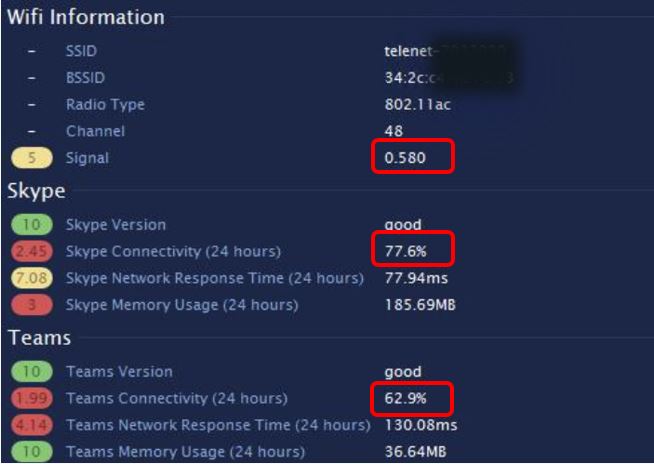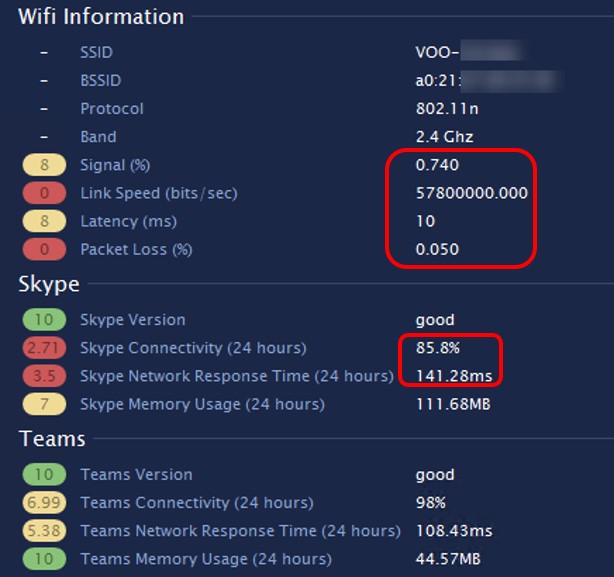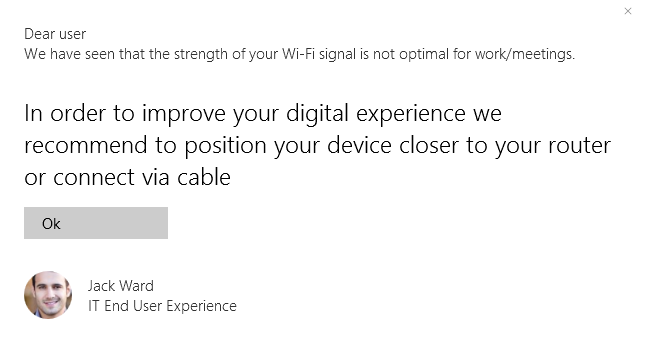How’s Your Wi-Fi Signal? IT’s Remote Work Blind Spot
Close your eyes for a moment and think of the least tech-savvy person in your family.
Ok, open them.
This person, even with their limited tech skills, probably understands that the farther you stray from your Wi-Fi router, the worse your connection will be.
Incredibly, Chris and I can count between us over a dozen customers whose IT support teams failed to consider this one factor.
How could something so simple fly under the radar of enterprise IT?
3 reasons:
- L1 support might be able to monitor your Wi-Fi strength but they can’t easily combine this information with other network performance statistics and they certainly cannot use this information to isolate anomalies or draw meaningful correlations
- IT cannot effectively target and communicate with remote employee subgroups or confirm their messages are being understood
- Tech support cannot measure how something, like Wi-Fi strength, impacts their company’s overall digital work experience.
To be fair to them, IT isn’t to blame—they can only do so much with the limited tools they have at their disposal.
Fortunately, several support teams are using Nexthink to identify how their employees’ home Wi-Fi affects their critical collaboration tools. These customers are then using our targeted messaging module (Engage) to quickly reconcile performance issues and to understand how those efforts impact their Digital Employee Experience.
Your Wi-Fi signal is but one piece of the puzzle
In late March, a global car manufacturing company asked us to solve their technology issues with Teams and Skype.
The company’s remote employees complained of dropped calls, poor video and audio quality, and a general slowness with these two applications.
Like many do in IT support, their team fell for a common trap: they were preoccupied with the speed of their network and less concerned with its quality. Video conferencing applications are sensitive to the quality of a network—and signal interference, for example, can cause data send errors that will decelerate a network’s speed. The stronger the signal, the less effect noise from other devices (mobile phones, microwaves, ipads, etc.) can have on a Teams or Skype call.
Working only off ticket data reported into L1 support, IT Ops assumed that roughly 1.3% of their remote workforce (260 people) were experiencing issues.
We’d soon show them how wrong those numbers were, but we first pointed their call center to Nexthink’s expansive built-in L1 checklists.
From a single pane, the L1 team was able to view a composite overview of their remote architecture that showed real-time network performance metrics, key Wi-Fi information, and digital experience scores categorized by Skype, Teams, and remote employee profile.
Two important findings emerged:
1. Employees with a weak Wi-Fi signal experienced worse connectivity and network response times than their colleagues with stronger home office signals.

2. And in a few cases, some employees had strong Wi-Fi signals (above 60%) but they still experienced poor Wi-Fi health (packet loss, latency, and link speed) which impacted their Skype & Teams connectivity.

Taking their investigation a step further, IT found that these two subgroups reported a drop in their overall Digital Employee Experience by as much as 5 percentage points (from 7.0 to 6.6) during the same time period these issues occurred.

With little else changing in their remote environment that week, the team felt confident they had isolated the main factors behind their Skype and Teams woes.
You said 1.3% of employees were affected? Guess again.
Thanks to Nexthink’s endpoint monitoring capabilities, the customer’s IT Ops team discovered their original numbers were way off.
Looking beyond just ticket data, the team found that roughly 3,000 employees (15% of their entire remote workforce) suffered the same type of Teams and Skype connectivity issues.
It was obvious then that many people failed to report their problems.
Acting on this information, they next used our platform to send targeted campaigns directly to those affected employees, offering clear, on-screen messages that asked them to move closer to their router.

And for those workers that had a good Wi-Fi signal but still suffered from poor Teams and Skype connectivity?
IT was able to reach out directly to these users with Nexthink’s targeted on-screen messages and help them switch to a stronger band on their router.
A week later, IT reported that all 3,000 employees had improved their Wi-Fi strength, overall Digital Employee Experience, and their Teams and Skype performance.

Do you want to solve your remote work problems quickly and at scale?
Many IT departments that use Nexthink are starting to realize the added power they have at their fingertips now that most, if not all, of their employees are working remotely.
IT can work more proactively and get ahead of issues when they have complete insight into their devices and end users, regardless of where those people are located.
Learn how we can help. Contact us today!
Alejandro Fisher, Service Delivery Manager
Chris Brown, Managed Services Consultant
Related posts:
- How IT Can Enable Smooth Digital Collaboration | Engagement and Automation
- Powering the Digital Employee Experience for Remote Workers
- Shadow IT: Why Tech Support Comes Up Short
- 7 Remote Work Problems IT Solved With Nexthink